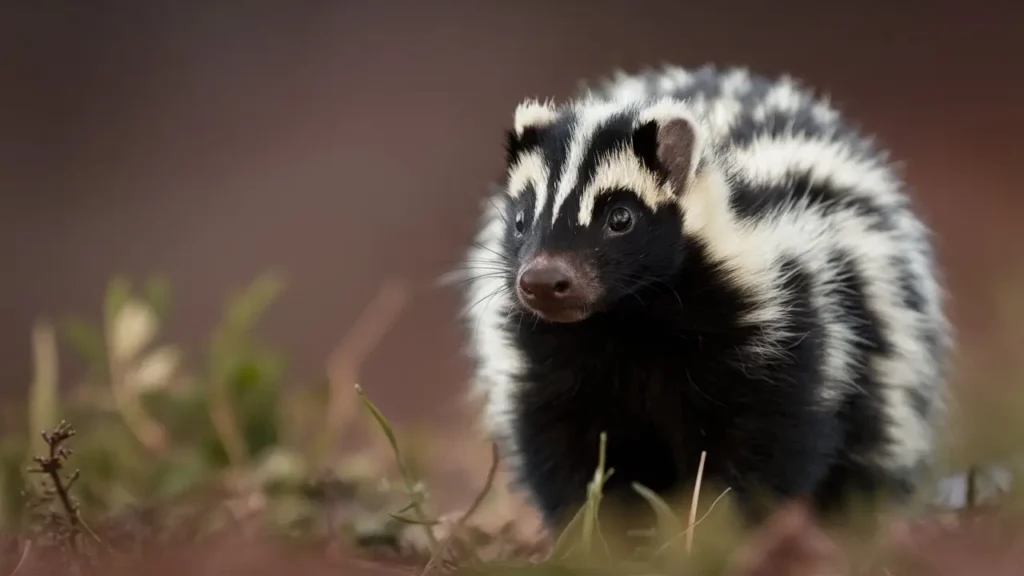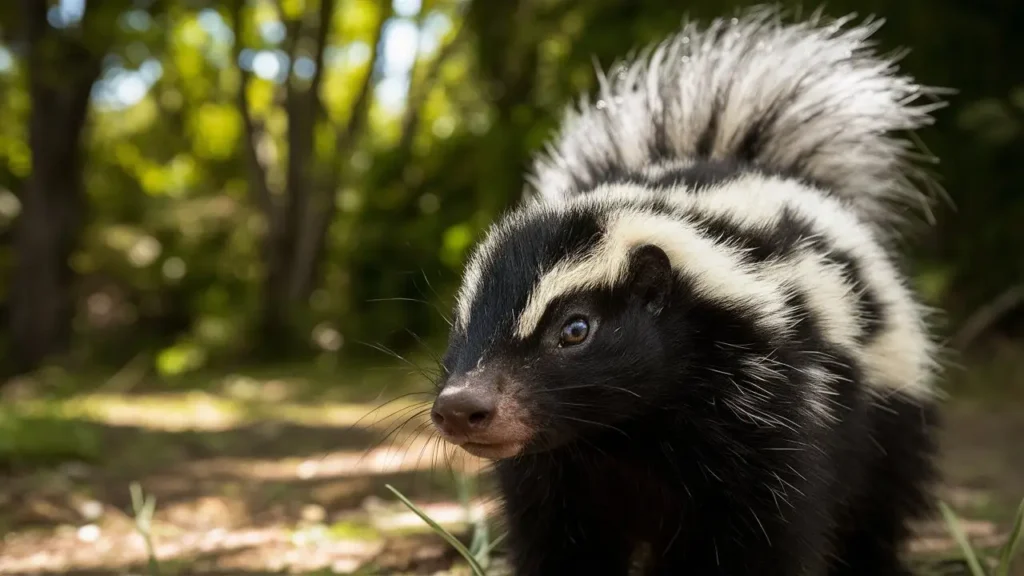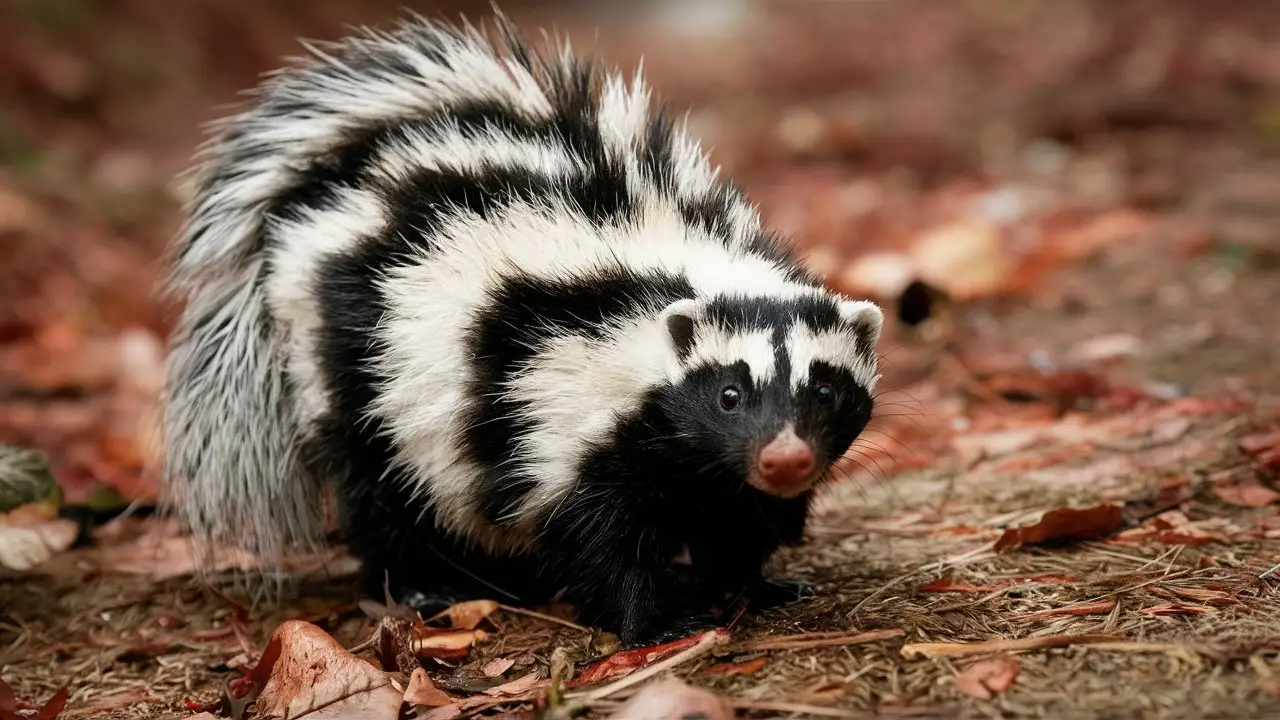Western Spotted Skunk (Spilogale gracilis)
The Western Spotted Skunk is a small, elusive member of the skunk family known for its intricate coat patterns, agility, and adaptable nature. Primarily found in western North America, this nocturnal carnivore plays a subtle yet important role in its ecosystems. By understanding its habitat, diet, behaviors, and the challenges it faces, we gain insight into the complexity and diversity of wildlife in these regions.
Physical Description
Size and Shape:
The Western Spotted Skunk is relatively petite. Adults measure about 34 to 38 centimeters (13 to 15 inches) in body length, excluding the tail. They typically weigh between 0.5 to 1.8 kilograms (1.1 to 4 pounds). Their compact, muscular build and short limbs are well-suited for agile movement, allowing them to climb trees and navigate tight spaces.
Coloration:
This species boasts a striking black coat accented by white spots and swirls. Unlike the more familiar striped skunks, the spotted skunk’s patterns break up its silhouette, providing a measure of camouflage in dappled forest light. A distinctive feature is their white-tipped tail, often fluffier than the rest of their fur.
Habitat and Distribution
Geographic Range:
The Western Spotted Skunk is found throughout parts of western North America, extending from regions of Canada down through the United States and into parts of northern Mexico. Its presence is most notable in states such as California, Nevada, Utah, Colorado, New Mexico, Arizona, and Texas.
Habitat Preferences:
Adaptability defines the Western Spotted Skunk. It thrives in a variety of habitats, including:
- Woodlands and Forests: Dense vegetation provides cover and abundant insect prey.
- Grasslands: Open areas allow for easy hunting of small mammals.
- Desert Edges: Resourceful skunks find shelter in rocky crevices and burrows.
- Agricultural and Suburban Areas: They sometimes venture near human settlements in search of easy food sources.
This habitat flexibility helps them cope with environmental changes, though it also increases the likelihood of encountering humans and domestic animals.

Diet and Feeding Behavior
Omnivorous Diet:
The Western Spotted Skunk is an omnivore, consuming a varied menu that shifts with the seasons. Common foods include:
- Insects: Beetles, grasshoppers, and crickets form a staple of their diet.
- Small Mammals: Mice and other rodents provide additional protein.
- Fruits and Berries: Plant matter offers energy and essential nutrients.
- Bird Eggs: On occasion, they raid nests for a nutritious treat.
Feeding Habits:
Primarily nocturnal, these skunks forage after dusk, relying on their keen sense of smell and hearing to locate prey. They tend to hunt alone, a strategy that reduces competition and the risk of attracting predators. Their diet’s flexibility enables them to adapt to changing food availability, ensuring year-round sustenance.
Behavioral Patterns
Nocturnal Activity:
Active primarily at night, the Western Spotted Skunk avoids daytime predators by foraging under the cover of darkness. Their exceptional climbing abilities allow them to scale trees, escape threats, and access food sources that other skunks cannot.
Social Behavior:
They are largely solitary, coming together only during the breeding season. Communication often takes the form of scent markings, body language, and occasional vocalizations rather than social bonding. This quiet, solitary lifestyle reduces conflict over resources.
Reproduction:
Mating generally occurs in the early spring. After a gestation period of roughly 50 to 65 days, females give birth to a litter of kits in a secure den. The young stay with their mother for a few months, learning essential skills such as foraging and using their defensive spray, before venturing out on their own.
Defense Mechanisms
Like other skunks, the Western Spotted Skunk is famed for its defensive spray, a pungent musk released from glands near the tail. However, before resorting to this powerful chemical defense, it often employs a characteristic warning display—balancing on its forelegs and arching its back—to appear more intimidating. This acrobatic performance often discourages predators from attacking.
Relationship With Humans
Encounters With People:
While generally shy and evasive, Western Spotted Skunks sometimes wander into suburban neighborhoods or farms in search of food. Though they rarely pose a serious threat, their presence near homes can lead to human-wildlife conflicts, especially if they raid garbage bins or henhouses. Understanding their behavior and habitat needs can reduce these encounters.eferences are as intriguing as their behavior. Let us uncover the places these elusive skunks call home.

Threats to Survival
Habitat Loss and Fragmentation:
Urban expansion, intensive agriculture, and deforestation reduce the suitable habitats available to these skunks. As they lose their natural homes, they are forced into riskier areas closer to human activity.
Predation and Disease:
Natural predators like great horned owls, coyotes, bobcats, and domestic dogs pose constant threats. Additionally, diseases such as canine distemper and rabies can significantly impact local populations.
Conservation Status:
Currently, the Western Spotted Skunk is not classified as highly endangered, but some regional populations face decline due to habitat alterations and other pressures. Conservation efforts that protect their habitats and reduce unnecessary pesticide use can help sustain their populations.
Frequently Asked Questions
Q: What is the lifestyle of a Western Spotted Skunk?
A: They are largely solitary, nocturnal foragers that rely on agility and a potent defensive spray. They inhabit various environments, from forests to grasslands, and adjust their diet according to seasonal availability.
Q: What is the habitat of the Western Spotted Skunk?
A: They occupy a broad range of habitats across western North America, including woodlands, grasslands, desert edges, and sometimes suburban areas where food and shelter are found.
Q: Do Western Spotted Skunks live in groups?
A: They are primarily solitary, coming together only briefly for breeding. Females raise their young alone until the kits are old enough to be independent.
Conclusion
The Western Spotted Skunk exemplifies nature’s ability to adapt and thrive in a variety of environments. Its stealthy nocturnal habits, flexible diet, and distinctive defense mechanisms enable it to persist despite habitat changes and human encroachment. By understanding and respecting these remarkable creatures, we can better appreciate the intricate tapestry of life that shares our world.

